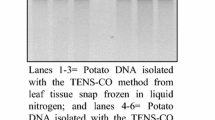Abstract
We developed a procedure to isolate DNA from dried corncobs. This DNA was amplified successfully by PCR, producing well-defined bands in response to specific primers. The SSR patterns between cob and leaf DNA of the same inbred line were found to be identical, indicating that the DNA in the cob cells had not degraded during senescence.
Similar content being viewed by others
References
Barnwell P, Blanchard AN, Bryant JA, Smirnoff N, and Weir AF (1998) Isolation of DNA from the highly mucilaginous succulent plantSedum telephium. Plant Mol Biol Rep 16: 133–138.
Benito CA, Figueiras M, Zaragoza C, Gallego FJ, and del Pena A (1993) Rapid identification of Triticeae genotypes from single seeds using the polymerase chain reaction. Plant Mol Biol 21: 181–183.
Brunel D (1992) An alternative, rapid method of plant DNA extraction for PCR analyses. Nucleic Acids Res 20: 4676.
Cano RJ, Poinar HN, Pieniazek NJ, Acra A, and Poinar Jr GO (1993) Amplification and sequencing of DNA from a 120–135-million-year-old weevil. Nature 363: 536–538.
Chaves AL, Vergara CE, and Mayer JE (1995) Dichloromethane as an economic alternative to chloroform in the extraction of DNA from plant tissues. Plant Mol Bio Rep 13: 18–25.
Cheng FS, Brown DK, and Weeden NF (1997) A DNA extraction protocol from various tissues in woody species. Hortscience 32: 921–922.
Cheung WY, Hubert N, and Landry BS (1993) A simple and rapid DNA microextraction method for plant animal and insect suitable for RAPD and other PCR analyses. PCR Meths Applics 3: 69–70.
Chunwongse J, Martin GB, and Tanksley SD (1993) Pre-germination genotypic screening using PCR amplification of half-seeds. Theor Appl Genet 86: 694–698.
Couch JA, and Fritz PJ (1990) Isolation of DNA from plants high in polyphenolics. Plant Mol Biol Rep 8: 8–12.
Csaikl UM, Bastian H, Brettschneider R, Gauch S, Meir A, Schauerte M, Scholz F, Sperisen C, Vornam B, and Ziegenhagen B (1998) Comparative analysis of different DNA extraction protocols: A fast, universal maxi-preparation of high quality plant DNA for genetic evaluation and phylogenetic studies. Plant Mol Biol Rep 16: 69–86.
Dellaporta SL, Wood J, and Hicks JB (1983a) Maize DNA minipreps. Maize Gent Coop News 57: 26–29.
Dellaporta SL, Wood J, and Hicks JB (1983b) A plant DNA minipreparation: version II. Plant Mol Biol Rep 1: 19–21.
Edwards K, Johnstone C, and Thompson C (1991) A simple and rapid method for the preparation of plant genomic DNA for PCR analysis. Nucl Acids Res 19: 1349.
Fang G, Hammar S, and Grumet R (1992) A quick and inexpensive method for removing polysaccharides from plant genomic DNA. Biofeedback 13: 52–54.
Fulton TM, Chunwongse J, and Tanksley SD (1995) Microprep protocol for extraction of DNA from tomato and other herbaceous plants. Plant Mol Bio Rep 13: 207–209.
Golenberg EM, Giannasi DE, Clegg MT, Smiley CJ, Durbin M, Henderson D, and Zurawski G (1990) Chloroplast DNA sequence from a miocene magnolia species. Nature 344: 656–658.
Guidet F (1994) A powerful new technique to quickly prepare hundreds of plant extracts for PCR and RAPD analyses. Nucleic Acids Res 22: 1772–1773.
Helentjaris T (1988) Does RFLP analysis of ancient Anasazi samples suggest that they utilized hybrid maize? Maize Genet Coop Newsletr 62: 104–105.
Kidwell KK and Osborn TC (1992) Simple plant DNA isolation procedures. In: Beckmann JS and Osborn TC (eds.), Plant Genomes: Methods for Genetic and Physical Mapping, pp 1–13, Kluwer Academic Pub, Netherlands.
Luro F and Laigret F (1995) Preparation of high molecular weight genomic DNA from nuclei of woody plants. Biotechniques 19: 388–392.
Marcos-Filho J, McDonald MB, TeKrony DM, and Zhang J (1997) RAPD fragment profiles from deteriorating soybean seeds. Seed Technology 19: 33–44.
Murray MG and Thompson WF (1980) Rapid isolation of high molecular weight plant DNA. Nucl Acids Res 19: 4321–4325.
Oard JH and Dronavalli S (1992) Rapid isolation of rice and maize DNA for analysis by random-primer PCR. Plant Mol Biol Rep 10: 236–241.
Quenzar B, Hartmann C, Rode A, and Benslimane A (1998) Date palm DNA minipreparation without liquid nitrogen. Plant Mol Biol Rep 16: 263–269.
Pandy RN, Adams RP, and Flournoy LE (1996) Inhibition of random amplified polymorphic DNAs (RAPDs) by plant polysaccharides. Plant Mol Biol Rep 14: 17–22.
Porebski S, Bailey LG, and Baum BR (1997) Modification of a CTAB DNA extraction protocol for plants containing high polysaccharide and polyphenol components. Plant Mol Biol Rep 15: 8–15.
Register III JC, Sullivan HR, Yu Y, Cook D, and Vaske DA (2001) A set of microsatellite markers of general utility in maize. Maize Gent Coop News 75: 31–34.
Rogers HJ, Burns NA, and Parkes HC (1996) Comparison of small-scale methods for the rapid extraction of plant DNA suitable for PCR analysis. Plant Mol Biol Rep 14: 170–183.
Saghai-Maroof MA, Soliman KM, Jorgensen RA, and Allard RW (1984) Ribosomal DNA spacer-length polymorphisms in barley: Mendelian inheritance, chromosomal location, and population dynamics. Proc Natl Acad Sci USA 81: 8014–8018.
Stewart Jr CN, and Via LE (1993) A rapid CTAB DNA isolation technique useful for RAPD fingerprinting and other PCR applications. BioTechniques 14: 748–749.
Vroh BI, Harvengt IL, Chandelier A, Mergeai G, and du Jardin P (1996) Improved RAPD amplification of recalcitrant plant DNA by the use of activated charcoal during DNA extraction. Plant Breeding 115: 205–206.
Walsh PS, Metzger DA, and Higuchi R (1991) Chelex 100 as a medium for simple extraction of DNA for PCR-based typing from forensic material. Bio Techniques 10: 506–513.
Wang G-L, Wing RA and Paterson AH (1993) PCR amplification from single seeds, facilitating DNA marker-assisted breeding. Nucleic Acids Res 21: 2527.
Ziegenhagen B, Guillemaut P, and Scholz F (1993) A procedure for mini-preparation of genomic DNA from needles of silver fir (Abies alba). Plant Mol Biol Rep 11: 117–121.




